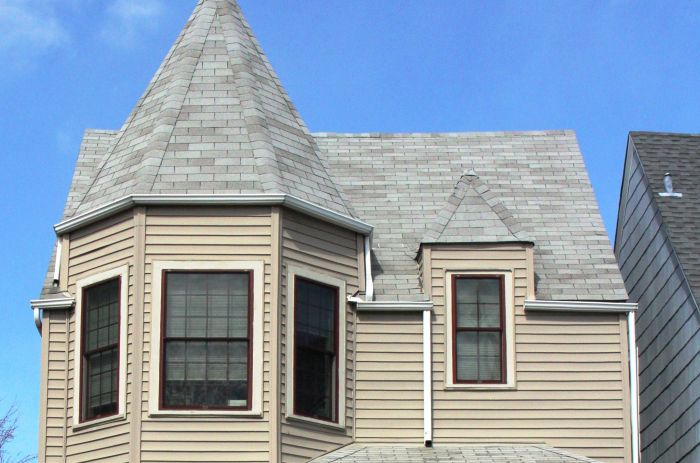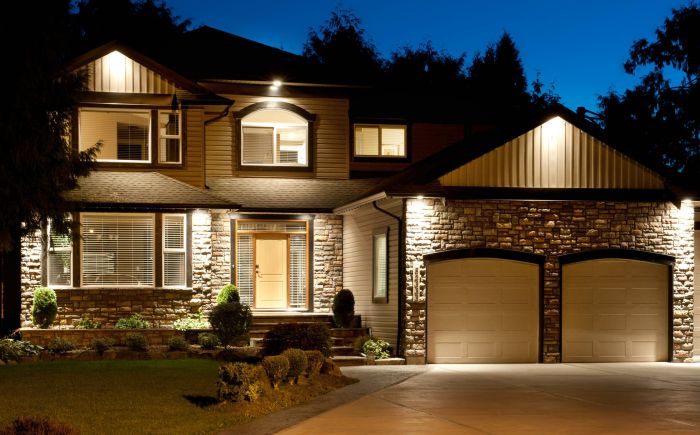Diving into the realm of exterior house siding, this introduction aims to captivate readers with a detailed look at the benefits, types, installation process, and maintenance of siding materials. From enhancing energy efficiency to boosting curb appeal, siding plays a crucial role in the aesthetics and functionality of a home.
As we explore the various aspects of exterior house siding, readers will gain valuable insights into the world of home improvement and maintenance.
Benefits of Exterior House Siding
Exterior house siding offers numerous advantages that go beyond just aesthetics. It plays a crucial role in protecting your home from the elements and enhancing its overall energy efficiency.
Improved Energy Efficiency
Exterior house siding acts as a protective barrier, helping to insulate your home and reduce heat loss during the colder months. This can lead to lower energy bills and a more comfortable living environment for you and your family.
- By adding insulation under the siding, you can further enhance the energy efficiency of your home, reducing the need for constant heating or cooling.
- Some siding materials, such as vinyl or fiber cement, have high thermal resistance properties, contributing to better insulation and energy savings.
- Properly installed siding can also prevent air leaks and drafts, creating a more airtight home that retains heat or cool air effectively.
Enhanced Curb Appeal
The exterior of your home is the first thing visitors and passersby notice, making curb appeal an essential aspect of homeownership. Exterior house siding can significantly impact the overall appearance of your home, giving it a fresh and attractive look.
- With a wide range of colors, textures, and styles available, siding allows you to customize the exterior of your home to match your personal taste and architectural style.
- Regular maintenance of siding can help preserve its appearance, preventing issues like fading, peeling, or warping that can detract from your home's curb appeal.
- Choosing high-quality siding materials can increase the value of your home, making it more appealing to potential buyers if you decide to sell in the future.
Types of Exterior House Siding Materials

When it comes to choosing the right siding material for your home, there are several options to consider. Each type of material has its own set of characteristics that affect durability, maintenance requirements, and cost-effectiveness.
Vinyl Siding
Vinyl siding is one of the most popular choices for exterior house siding due to its affordability and low maintenance requirements. It is durable, resistant to moisture, and comes in a variety of colors and styles. However, vinyl siding can crack or fade over time, and it may not be as long-lasting as other materials.
Fiber Cement Siding
Fiber cement siding is a versatile and durable option that can mimic the look of wood, stucco, or masonry. It is resistant to fire, insects, and rot, making it a low-maintenance choice for homeowners. While fiber cement siding is more expensive upfront, it can last for decades with minimal upkeep.
Wood Siding
Wood siding provides a natural and classic look to a home, but it requires more maintenance than other materials. Regular painting or staining is necessary to protect the wood from moisture and pests. While wood siding can be costly and time-consuming to maintain, it offers a timeless aesthetic that many homeowners appreciate.
Aluminum Siding
Aluminum siding is lightweight, durable, and resistant to rust and corrosion. It is a cost-effective option that requires minimal maintenance. However, aluminum siding can dent easily and may not provide as much insulation as other materials.
Brick Siding
Brick siding is a durable and long-lasting option that can add a timeless and elegant look to a home. While brick siding is more expensive upfront, it requires little maintenance and can last for generations. It also provides excellent insulation properties, helping to reduce energy costs over time.
Installation Process of Exterior House Siding

The installation process of exterior house siding is crucial for enhancing the aesthetic appeal and protecting the structure of your home. Proper installation ensures durability and longevity of the siding, providing insulation and weather resistance
Steps Involved in Installing Exterior House Siding
- Prepare the Surface: Clean the existing surface thoroughly, remove any debris, and repair any damages before installation.
- Measure and Cut the Siding: Accurately measure the dimensions of the walls and cut the siding panels accordingly to fit perfectly.
- Start from the Bottom Up: Begin installing the siding from the bottom of the wall and work your way up, ensuring proper alignment and overlapping of panels.
- Secure the Siding: Use appropriate fasteners to secure the siding panels to the wall, following manufacturer guidelines for spacing and placement.
- Finish with Trim: Complete the installation by adding trim pieces around windows, doors, and corners for a polished look.
Tips for Preparing the Surface before Installing Siding
- Inspect for Rot or Mold: Check for any signs of rot or mold on the existing surface and address these issues before installing the siding.
- Apply a Moisture Barrier: Install a moisture barrier or house wrap to protect the underlying structure from water damage.
- Check for Levelness: Ensure the walls are level and straight to prevent any issues with the alignment of the siding panels.
Common Challenges Faced During the Installation Process
- Warped Siding Panels: If the siding panels are warped, use a level to adjust and ensure proper alignment during installation.
- Inaccurate Measurements: Double-check all measurements to avoid cutting siding panels too short or too long, leading to gaps or overlaps.
- Weather Conditions: Install siding on a dry and mild day to prevent issues with expansion or contraction due to temperature changes.
Maintenance and Care for Exterior House Siding
Proper maintenance and care for your exterior house siding are essential to ensure its longevity and keep your home looking its best. Regular cleaning, inspections, and repairs can help prevent damage and extend the lifespan of your siding.
Cleaning Different Types of Siding Materials
- Vinyl Siding: Use a mixture of water and mild detergent to scrub away dirt and grime. Avoid using harsh chemicals or abrasive tools that can damage the surface.
- Wood Siding: Regularly clean with a solution of water and mild soap to prevent mold and mildew growth. Consider applying a fresh coat of paint or stain every few years to protect the wood.
- Fiber Cement Siding: Use a soft brush or cloth to remove dirt and debris. Avoid high-pressure washing, as it can cause water damage to the siding.
- Aluminum Siding: Clean with a mixture of water and vinegar to remove oxidation and stains. Rinse thoroughly with water to prevent residue buildup.
Importance of Regular Inspections and Repairs
- Inspect your siding annually for signs of damage, such as cracks, warping, or loose panels. Address any issues promptly to prevent further damage and maintain the integrity of your siding.
- Repair small cracks or holes with caulk or sealant to prevent water infiltration and potential rot. Replace damaged or missing pieces of siding to maintain a cohesive appearance.
Tips for Protecting Siding from Weather Elements and Pests
- Trim back trees and shrubs near your home to prevent branches from scratching or causing damage to your siding during storms.
- Seal gaps and cracks around windows, doors, and vents to prevent water and pests from entering and causing damage to your siding.
- Consider installing a vapor barrier or insulation behind your siding to protect against moisture and improve energy efficiency.
Ending Remarks

In conclusion, exterior house siding is not just about aesthetics; it's about protecting your home, improving energy efficiency, and increasing property value. By understanding the different materials, installation processes, and maintenance tips, homeowners can make informed decisions to keep their siding looking great for years to come.
Quick FAQs
How can exterior house siding improve energy efficiency?
Exterior house siding acts as an extra layer of insulation, reducing heat loss in the winter and heat gain in the summer, thus improving energy efficiency.
What are the common challenges faced during the installation process of exterior house siding?
Common challenges include ensuring proper alignment, dealing with uneven surfaces, and addressing any structural issues before installing the siding.
How often should exterior house siding be inspected for maintenance?
It is recommended to inspect siding at least once a year to check for any damage, mold, or signs of wear and tear that may require repairs.
